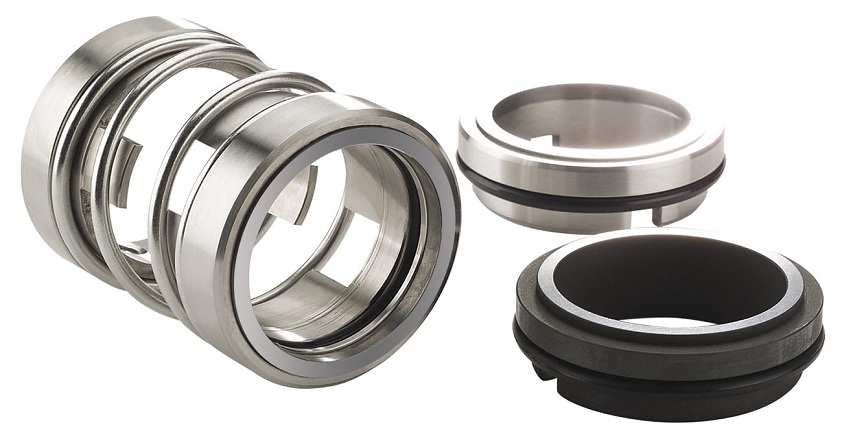Posted At: Apr 02, 2025 - 395 Views

How Does a Mechanical Seal Work in Pump Applications?
In the intricate world of industrial pumping, the ability to contain fluids without leakage is paramount. This is where the mechanical seal, an often-overlooked yet critical component, plays its vital role. Understanding how does a mechanical seal work is not just a technical curiosity; it’s essential for optimizing pump performance and ensuring operational efficiency.
What Are Mechanical Seals?
To truly grasp the concept of what are mechanical seals, we must move beyond a simple definition. These are sophisticated devices designed to create a dynamic seal between a rotating shaft and a stationary pump casing, preventing fluid leakage. Unlike traditional packing, which relies on compression and can lead to excessive wear and leakage, mechanical seals utilize precision-engineered surfaces and a thin film of fluid to achieve a near-zero leakage rate.
Deconstructing How Mechanical Seal Works
To comprehend how mechanical seal works, we must dissect its components and understand their individual functions:
Rotary Face (Rotating Element): This component, attached to the pump shaft, is the dynamic part of the seal. It’s typically crafted from materials like silicon carbide (SiC), tungsten carbide (WC), or ceramics, chosen for their exceptional hardness and wear resistance. The rotary face’s surface finish is critical; it must be extremely smooth to minimize friction and ensure a consistent fluid film.
Stationary Face (Stationary Element): This component, fixed to the pump casing, provides the mating surface for the rotary face. It’s often made from a softer material, such as carbon graphite, which can conform to minor imperfections in the rotary face. This material also provides a degree of self-lubrication.
Springs and Pushers: These components provide the necessary axial force to maintain contact between the rotary and stationary faces. The spring’s design and material are crucial for ensuring consistent face loading and compensating for wear.
Elastomers (O-rings, Gaskets, Bellows): These components, made from materials like Viton, EPDM, or PTFE, provide static sealing between the seal components and the pump housing or shaft. They prevent leakage at points other than the primary sealing faces. Bellows are a type of elastomer that can be used to replace springs in certain applications, providing axial movement and flexibility.
Retainer and Gland Plate: these components hold the spring, rotary and stationary faces in place, and also help to mount the stationary face to the pump casing.
Sleeve: A sleeve is an optional component that is fitted over the pump shaft, and the rotating element of the seal is mounted to the sleeve. This component protects the shaft from wear, and corrosion.
The Science of Sealing: How Mechanical Seal Works in Detail
The core of how mechanical seal works lies in the creation and maintenance of a thin, lubricating fluid film between the rotary and stationary faces:
- Initial Contact and Fluid Ingress: When the pump starts, the spring force pushes the rotary face against the stationary face, establishing initial contact. The microscopic imperfections on the face surfaces allow a small amount of the pumped fluid to enter the gap.
- Hydrodynamic Lubrication and Film Formation: As the shaft rotates, the fluid film between the faces generates hydrodynamic pressure. This pressure lifts the faces slightly, creating a thin, lubricating film that prevents direct contact. This film is crucial for minimizing friction and wear.
- Leakage Control and Fluid Barrier: The extremely narrow gap between the faces, typically measured in microns, restricts the flow of fluid, resulting in minimal leakage. The fluid film acts as a dynamic barrier, preventing significant fluid loss.
- Heat Dissipation and Cooling: The fluid film also serves as a coolant, dissipating the heat generated by friction between the faces. This prevents seal damage and ensures stable operation.
Seal Pump Applications: Tailoring Seals to Specific Needs
The selection of a mechanical seal is highly dependent on the specific seal pump application. Factors to consider include:
- Fluid Properties: Corrosive, abrasive, viscous, or high-temperature fluids require specialized seal materials and designs.
- Operating Pressure and Temperature: High-pressure and high-temperature applications necessitate seals with robust designs and materials capable of withstanding extreme conditions.
- Shaft Speed and Vibration: High-speed applications require seals with balanced designs to minimize vibration and ensure stability.
- Pump Design and Installation: The pump’s design and the seal’s installation can significantly impact seal performance.
Maintenance and Troubleshooting: Ensuring Seal Longevity
Proper maintenance is essential for maximizing the lifespan of a mechanical seal. Common issues include:
Abrasive Wear: Caused by abrasive particles in the pumped fluid.
Corrosion: Resulting from corrosive fluids attacking seal materials.
Thermal Cracking: Due to excessive heat generated by friction or inadequate cooling.
Elastomer Degradation: Caused by chemical attack or high temperatures.
Improper installation: Leading to premature failures.
Regular inspections, proper lubrication, and adherence to manufacturer guidelines can help prevent these issues.
The Advantages of Mechanical Seals: A Superior Sealing Solution
Compared to traditional packing, mechanical seals offer numerous advantages:
Reduced Leakage: Minimizing product loss and environmental contamination.
Lower Friction: Resulting in energy savings and reduced wear.
Longer Service Life: Decreasing downtime and maintenance costs.
Improved Reliability: Ensuring consistent and reliable pump operation.
Reduced maintenance: less required adjustments.
Conclusion
Understanding how does a mechanical seal work is fundamental to ensuring efficient and reliable pump operation. By carefully selecting and maintaining these critical components, industries can minimize fluid leakage, reduce downtime, and optimize their pumping systems.


